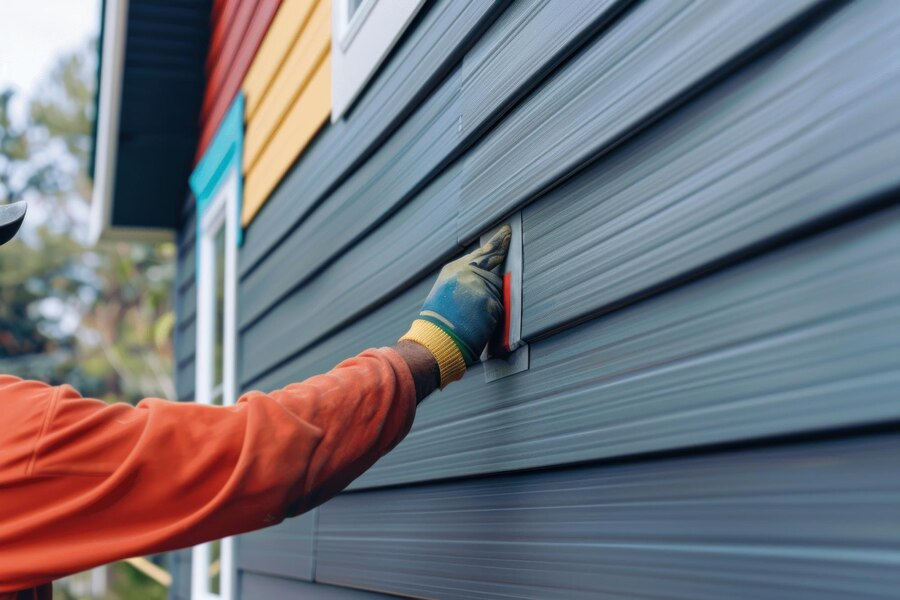
Siding Maintenance: Keeping Your Home Protected
Your home’s siding is more than just a protective layer; it plays a significant role in its appearance and overall durability. Proper maintenance is essential to ensure that siding continues to perform well and keep your home looking its best. Whether you have vinyl, wood, fiber cement, or metal siding, understanding how to care for it can prolong its lifespan and save you from costly repairs. In this comprehensive guide, we’ll cover everything you need to know about siding maintenance, including tips for different types of siding, common issues, and preventative measures to keep your home protected.
Why Siding Maintenance Matters
Siding serves as your home’s primary defense against harsh weather conditions, including rain, wind, snow, and harmful UV rays. It not only protects the structural integrity of your home but also provides an additional layer of insulation and enhances its curb appeal. Proper siding maintenance is essential because it helps preserve these protective and aesthetic functions, ensuring that your home remains safe and visually appealing.
Neglecting maintenance can lead to significant problems such as water damage, which may cause rot and mold, and pest infestations that can further compromise the siding’s effectiveness. By addressing minor issues as they arise, homeowners can prevent these problems from escalating into costly repairs and maintain their home’s value and comfort over the long term.
General Maintenance Tips for All Types of Siding
Regardless of the type of siding you have, there are some general maintenance tips that apply to all:
Regular Cleaning
Maintaining a clean siding surface is vital for preserving its look and function. Use a soft brush or cloth with mild detergent to remove dirt, grime, and mold. Steer clear of harsh chemicals and abrasive tools that could damage or discolor the siding.
Inspect for Damage
Consistent inspections are crucial to identify potential issues like cracks, holes, or warping in your siding. Addressing these problems promptly helps prevent them from worsening and necessitating more extensive and costly repairs down the line.
Check for Mold and Mildew
Moisture buildup can foster mold and mildew, damaging your siding and impacting indoor air quality. Regularly check for dark spots or patches and clean them using a solution of water and vinegar or a dedicated cleaner to mitigate these issues.
Sealant and Caulking
Inspect the caulking around windows, doors, and other joints to ensure it remains intact. Reapply sealant as necessary to prevent water from seeping behind the siding, which can cause significant damage if left unaddressed.
Gutter Maintenance
Keeping gutters and downspouts free from debris is essential for proper water drainage. Clogged or overflowing gutters can lead to water damage and siding problems, so regular cleaning and maintenance are necessary to protect your home’s exterior.
Vinyl Siding Maintenance
Vinyl siding is popular for its low maintenance and durability. However, it still requires some attention:
Washing
Clean vinyl siding at least once annually with a solution of water and mild detergent. While a power washer can be effective, use it with caution, as excessive pressure can cause damage or warping to the vinyl siding.
Stain Removal
For persistent stains on vinyl siding, use a mixture of water and a non-abrasive cleaner. Avoid bleach or abrasive scrubbing pads, as these can damage the vinyl surface and diminish its appearance over time.
Inspecting and Repairing
Regularly inspect vinyl siding for loose or damaged panels. Promptly replace or repair any issues to ensure the siding’s effectiveness and maintain its overall integrity and protective qualities.
Avoiding Scratches
Vinyl siding can be susceptible to scratches from objects or during maintenance. Handle the siding gently and avoid using sharp tools or abrasive materials to prevent damaging the surface.

Wood Siding Maintenance
Wood siding adds a classic and natural look to homes but requires more upkeep compared to other materials:
Painting and Staining
Wood siding should be painted or stained every 3-7 years, depending on the climate and exposure to the elements. This helps protect the wood from moisture, sun damage, and pests.
Inspecting for Rot
Regularly check for signs of rot or decay, especially around the base and where water tends to accumulate. Replace any damaged boards to prevent the spread of rot.
Pest Control
Wood siding can attract pests like termites and carpenter ants. Ensure that the siding is properly sealed and address any pest issues immediately.
Cleaning
Use a soft brush or cloth and a mild detergent to clean wood siding. Avoid using high-pressure washers, which can damage the wood.
Fiber Cement Siding Maintenance
Fiber cement siding is known for its durability and low maintenance requirements. However, it still benefits from regular care:
- Cleaning: Clean fiber cement siding with a garden hose or low-pressure washer. Use a mild detergent if needed to remove stains or dirt.
- Inspecting for Cracks: Check for cracks or chips in the siding, especially after severe weather. Repair any damage to prevent water infiltration and further issues.
- Painting: Fiber cement siding may need painting every 10-15 years. Choose a high-quality exterior paint and follow manufacturer recommendations for best results.
- Preventing Mold: In areas with high humidity, fiber cement siding can be prone to mold growth. Use a mixture of water and bleach to remove any mold and prevent it from recurring.
Metal Siding Maintenance
Metal siding, often made from aluminum or steel, is highly durable but requires some care:
- Cleaning: Wash metal siding with a mild detergent and water to remove dirt and grime. Use a soft brush to avoid scratching the surface.
- Inspecting for Dents and Scratches: Regularly check for dents, scratches, or rust spots. Address any damage promptly to prevent rust from spreading.
- Rust Prevention: Apply a rust-inhibiting primer and paint to any areas affected by rust. Keep metal siding well-painted to prevent future rust issues.
- Checking Fasteners: Ensure that all fasteners and screws are secure. Tighten any loose fasteners to prevent issues with the siding’s stability.
Common Siding Issues and How to Address Them
Water Damage
Water damage can stem from improper installation, leaks, or clogged gutters. To prevent further issues, identify and address the source of the water problem, repair any damaged siding, and ensure proper sealing to safeguard against future water-related damage.
Mold and Mildew
Mold and mildew can develop on any siding, particularly in damp climates. Clean affected areas with suitable cleaning solutions and address underlying moisture problems to prevent mold and mildew growth, which can damage the siding and affect indoor air quality.
Cracking and Warping
Cracking and warping of siding often result from extreme weather conditions or poor installation. Repair or replace damaged sections promptly and ensure correct installation practices to prevent these issues from recurring and compromising the siding’s effectiveness.
Pest Infestations
Pests, such as termites or carpenter ants, can damage wood and fiber cement siding. Treat affected areas and implement preventative measures, including sealing gaps and maintaining a pest-free environment, to protect siding from pest-related damage.
Preventative Measures
Regular Inspections
Perform routine inspections of your siding to identify any emerging issues early on. Addressing minor problems right away can prevent them from escalating into major concerns that could lead to extensive and costly repairs.
Ensure that siding is installed correctly by a qualified professional. Proper installation is crucial to avoid common problems like water infiltration, gaps, or poor performance, which can compromise the siding’s effectiveness and your home’s protection.
Maintain Gutters and Downspouts
Regularly clean gutters and downspouts to keep them free of debris and ensure effective water drainage away from the siding. Clogged gutters can lead to water damage and siding issues, making regular maintenance essential.
Address Moisture Issues
Identify and resolve any sources of excess moisture around your home, such as leaks or poor drainage. Properly addressing these issues helps prevent water damage and deterioration to the siding, preserving its integrity and performance.
Conclusion
Maintaining your siding is essential for protecting your home and preserving its appearance. Address issues like water damage, mold, cracking, and pest infestations promptly to avoid more significant repairs. Regular inspections, proper cleaning, and preventative measures can help extend the lifespan of your siding and keep your home looking its best. For expert advice and professional siding maintenance services in Akron, OH, contact EZ Window Solutions of Akron at (440) 773-4396. Ensuring your siding remains in top condition will enhance your home’s durability and curb appeal for years to come.


Write a Comment